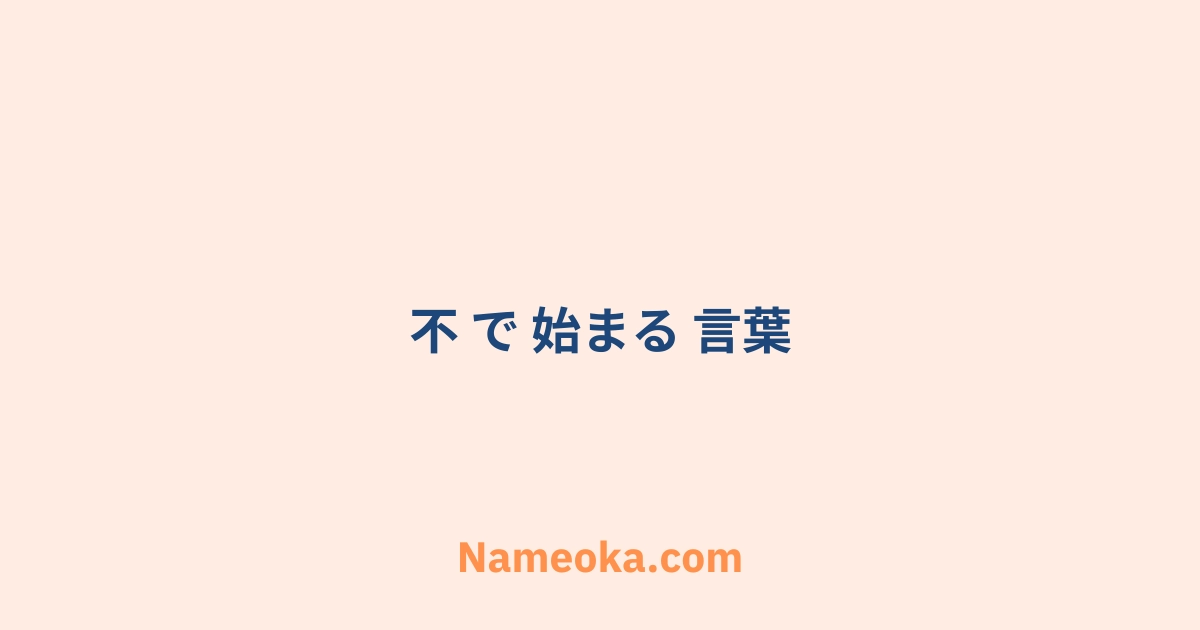不で始まる言葉は日本語における重要な要素で、否定や反対の意味を持つことが多いです。日常会話やビジネスシーンで頻繁に使われるこれらの言葉は、表現を豊かにし、対話を深める役割を果たします。不で始まる言葉の持つニュアンスを理解することで、より正確に自分の意図を伝えることが可能になります。この記事では、その豊富な使い方や注意点について詳しく探ります。.

49+ 不 で 始まる 言葉
- 1. 不安
- 2. 不意
- 3. 不運
- 4. 不可
- 5. 不覚
- 6. 不吉
- 7. 不況
- 8. 不潔
- 9. 不幸
- 10. 不才
- 11. 不作
- 12. 不足
- 13. 不正
- 14. 不全
- 15. 不即
- 16. 不調
- 17. 不特定
- 18. 不透明
- 19. 不当
- 20. 不備
- 21. 不明
- 22. 不要
- 23. 不良
- 24. 不利
- 25. 不礼儀
- 26. 不労
- 27. 不安定
- 28. 不確実
- 29. 不規則
- 30. 不完全
- 31. 不機嫌
- 32. 不気味
- 33. 不経済
- 34. 不合理
- 35. 不幸中
- 36. 不自由
- 37. 不十分
- 38. 不正確
- 39. 不誠実
- 40. 不足気味
- 41. 不適
- 42. 不平
- 43. 不偏
- 44. 不本意
- 45. 不満
- 46. 不毛
- 47. 不眠
- 48. 不容易
- 49. 不快
- 50. 不相応
不 Words In Japanese Culture And Society
In Japanese culture and society, the prefix “不” (pronounced as “fu” or “bu”) is a negative prefix, meaning “non-“, “un-“, “dis-” or “in-“. It is used to form antonyms or to indicate the absence of something. Here are a few examples of how it is used in Japanese:
不安 (ふあん, fuan): This means “anxiety” or “unease,” where “安” means “ease” or “calm,” and the prefix “不” negates it.
不便 (ふべん, fuben): Meaning “inconvenient,” combining “便” which means “convenience” with “不.”
不足 (ふそく, fusoku): This translates to “insufficient” or “lack,” where “足” means “sufficient” or “enough.”
不公平 (ふこうへい, fukōhei): Meaning “unfair,” with “公平” meaning “fair.”
不可能 (ふかのう, fukanō): Meaning “impossible,” where “可能” indicates “possible.”
The prefix “不” is commonly used to express negation or the absence of a quality in various contexts, from everyday conversation to formal settings in Japan. Its use is prevalent in both spoken and written Japanese, reflecting its importance in the language.
The Historical Origins Of 不 In The Japanese Language
The character 不 (pronounced “fu” or “bu” in Japanese) is of Chinese origin and is a key component of both the Japanese and Chinese writing systems. In the context of Japanese, it was adopted through the process of kanji importation during periods of cultural exchange between Japan and China, particularly during the Asuka, Nara, and early Heian periods (roughly the 5th through 9th centuries).
不 is a negation prefix and is one of the common kanji that indicates a negative meaning. In classical Chinese, as well as in its use throughout East Asian languages, it served to negate verbs and adjectives. Its meaning as a negation prefix is retained in Japanese, where it is used in various compounds to convey the absence, lack, or negation of an action or quality.
In the process of adapting Chinese characters, known as kanji, for use in Japanese, many characters like 不 were integrated not just for their meanings but also as phonetic elements. Japanese syntax and grammar were—and remain—quite different from Chinese, so while the individual characters were adopted, their use was adapted to fit the structure and needs of the Japanese language.
As a result, 不 appears in a variety of compound words and plays a significant role in the Japanese lexicon, functioning similarly to a prefix that negates the meaning of the word or phrase it precedes. Examples include 不安 (fuan, meaning uneasy or anxious) and 不便 (fuben, meaning inconvenient).
Moreover, the adoption and adaptation of kanji like 不 facilitated the development of Japanese writing systems and led to the creation of kana (hiragana and katakana), which helped accommodate the native Japanese vocabulary that had no direct Chinese equivalents.
The Impact Of 不 Prefixes On Meaning In Japanese Adjectives And Verbs
In Japanese, the prefix “不” (pronounced “fu” or “bu” depending on the phonetic context) is used to negate or reverse the meaning of the word it is attached to. This prefix is often added to adjectives and verbs to convey a sense of “not” or “un-,” similar to prefixes like “un-” and “in-” in English. Here’s how it impacts meaning:
Adjectives
When “不” is attached to adjectives, it usually indicates the absence or negation of a particular quality. Here are some examples:
- 不便 (ふべん, fuben): “ben” means “convenient,” so “fuben” means “inconvenient.”
- 不安 (ふあん, fuan): “an” means “peace,” so “fuan” means “anxiety” or “uneasiness.”
- 不満 (ふまん, fuman): “man” means “full” or “satisfaction,” so “fuman” means “dissatisfaction.”
Verbs
When added to verbs, “不” typically creates a word that implies an unwillingness or inability to perform the action. Some examples include:
- 不参加 (ふさんか, fusanka): “sanka” means “participate,” so “fusanka” means “non-participation.”
- 不成功 (ふせいこう, fuseikou): “seikou” means “success,” so “fuseikou” means “failure.”
- 不使用 (ふしよう, fushiyou): “shiyou” means “use,” so “fushiyou” means “non-use” or “not using.”
Usage Notes
- While “不” is a common negation prefix, it’s more formal and is often used in written language, official documentation, or more sophisticated vocabulary. In everyday conversation, native speakers might use other simple negation forms or words instead.
- Be cautious with pronunciation, as the prefix can change depending on the following consonant (e.g., “fu” becomes “bu” in “fuben”).
- Not all adjectives and verbs can take the “不” prefix, and there might be other ways to express negation.
Overall, understanding the use of “不” as a prefix can help in comprehending the nuance and context of words in more formal or written Japanese communication.
よくある質問
不で始まる言葉にはどんなものがありますか?
不安、不明、不利、不正など様々な言葉があります。これらは多くの場合、否定的な意味を持ちますが、文脈によってポジティブな解釈も可能です。.
不で始まる言葉の使い方を教えてください。
たとえば、「不安」は心配や恐れを感じる状態を表します。一方、「不可能」は物事が実現しない状況を指します。日常会話や学習においてこれらの言葉を適切に使うことで、意思疎通がスムーズになります。.
不で始まる言葉を学ぶメリットは何ですか?
不で始まる言葉を学ぶことで、否定形の言葉や概念を理解しやすくなります。また、表現の幅が広がり、より深い会話が可能になります。特にビジネスや学術的な場面で役立つでしょう。.












